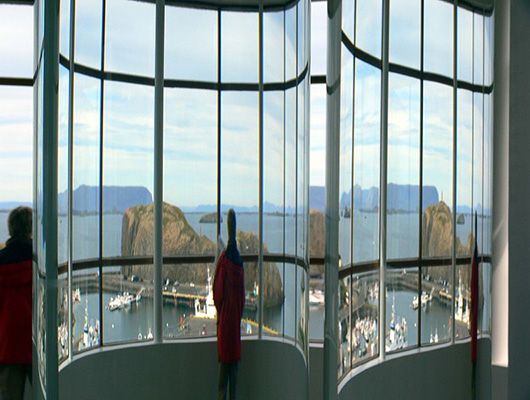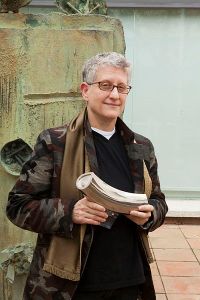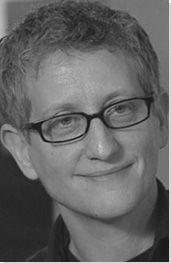Summary of Roni Horn
Roni Horn is a challenging artist to define because her methods and mediums are steeped in the same sense of ambiguity that drives her own gender neutral, fluid-identified existence. Rather than rely on categorization, or underlying message, her art is about instigating a relationship with the viewer that jostles and provokes myriad perceptions. She creates conceptual circumstances that combine installation, material, place, and language in a Post-Minimalist fashion to emphasize the centrality of a witnessing mind and body to the meaning of a work.
Accomplishments
- The gesture of doubling, or presenting pairs as an aesthetic or conceptual strategy, has been a recurrent motif for Horn. Her interest in this technique lies in its ability to invite the viewer to scrutinize more carefully what and how they are seeing, thus altering the overall dynamic of the artwork.
- Horn consistently thwarts closure within the viewer by creating pieces that thrive on uncertainty and cause a person to temporarily rejigger their personal lens to adjust to the world of the artwork, upon which they have entered, and from which they will depart questioning the validity of fixed identities.
- Place is an important component in Horn's art. Whether confined within a museum room, or orchestrated in collaboration with an existing environment such as her beloved Iceland, an artwork's location is as essential to its final impact as the intended subject or original matter.
- Driven by a deep love of solitude and creative sanctuary, Horn and her art are elementally entwined as documentation of a life spent investigating mutability, multiplicity, and meaning.
Important Art by Roni Horn
Gold Field
One of Horn's earliest mature works, Gold Field is a 49 x 60 inch sheet of impossibly thin gold leaf laid on the gallery floor. Made of a single material, the work examines how sculptural presence is achieved. Guggenheim curator Ted Mann says: "Unadorned and set directly on the floor without a pedestal, it is in fact not so much a sculpture as the material of gold itself - 'the simple physical reality' of the stuff, in the artist's words."
Horn's interest in gold as a material goes back to her childhood and growing up among the items of her father's profession as a pawnbroker. The work hints at the multiple layers of monetary and mythological connotations associated with gold but also subverts them by offering the simplest version of the material. "In Gold Field," Mann argues, "she sought to strip away these cultural associations to allow viewers to experience the material unmediated, as a visual and tactile thing."
Nevertheless, the thinness of the gold leaf gives the piece a fragility and vulnerability, which is likely to create an emotional response. For instance, the artist Felix Gonzalez-Torres, whose partner was dying of AIDS, had a strong reaction to Horn's work: he wrote that the work was "waiting for the right viewer willing and needing to be moved to a place of the imagination." Within the context of the socially, economically and even biologically turbulent early 1980s, Horn's Gold Field could be read as a symbol of hope, or as Gonzalez-Torres put it, "a new landscape, a possible horizon, a place of rest and absolute beauty."
The work has similarities to various floor-based works by Minimalist artists, such as Carl Andre's Steel Zinc Plain (1961). However, the intended mode of interaction between visitor and work is very different. Although, as Tate's conservation team points out, the "artworks have much in common, the two artists desired very differing types of interaction with their work." Whereas "it has always been clear that Andre's metal floor works are meant to be walked upon," the fragility of Horn's work makes this impossible. While Andre emphasizes the relationship between the artwork and the space in which it is sited, Horn prefers to emphasize the uniquely affective materiality of gold and the physical and emotional relationship the viewer has with that material.
Pure gold - Guggenheim, US
Things That Happen Again: For Two Rooms
This work is part of a series of "Pair Objects" made by Roni Horn in the late 1980s. The work consists of two machined copper cylinders placed in separate rooms. The viewer sees one before going into the next room to be faced with the same set-up. The machined works are identical in every way, subverting questions about the artist's craft and about the uniqueness of the art-object. Horn explains: "With one object, its presence is emanating out into the world with it as its center. With two objects that are one object, you have an integral use of the world. You have the necessary inclusion of circumstance."
Circumstance here arrives as the experience of seeing two objects which appear to be identical in identical contexts one after the other becomes uncanny for the viewer, who is never given the opportunity to examine the two pieces side by side to confirm whether they are truly identical. The curators of the exhibition titled "Roni Horn aka Roni Horn" at Tate Modern in 2009 noted, "Though the cone in the next room is identical, the experience is different because it is filtered through the memory of the first object. The effect can be disconcerting, since the viewer cannot check if the parts are the same."
The works draw from the Minimalist tradition in the use of industrial production techniques, simple geometric form, and attention to materiality. However, they significantly move away from Minimalism in the importance placed on the viewer in relation to the objects and on the fact that the viewer experiences the works in real time by walking from one to the other.
Copper - Hauser & Wirth, Zürich
You are the Weather
In the mid-1990s, Roni Horn created her first photographic installation You are the Weather, featuring 100 close-ups of one woman named Magret. Each image is a tightly cropped shot of the woman's face as she leans down to gaze into a pool of Icelandic water. The model's face carries an almost imperceptible variation of expression from image to image, mostly different degrees of squinting. These small changes are a result of the weather (light and humidity levels) at the time when the photograph was taken. Viewers are thusly placed in a similar role to the weather in witnessing the woman's transformation of face, informing the piece's name.
The woman's face becomes like a place or landscape, moulded by the repetitive actions of the living environment. This subtle testament to time and physical transformation gives the piece its power, because as Dia Art Foundation's senior curator Donna De Salvo explains, "The faces require this incredibly acute and precise eye. They really draw you in." Again, Horn is waxing poetic on twin passions that compel her, those of mutability and place.
Horn also draws attention to the notion of looking at art as a voyeuristic practice, effectively turning the tables on the viewer. She writes, "the way this work is shot and installed, the viewer is voyeurized by the view. You are surrounded by a woman who is staring at you." Although we are used to watching the weather, we generally do not consider that the weather might be watching us.
36 gelatin silver prints and 64 chromogenic prints - Hauser & Wirth Zürich London
Key and Cues No. 1755, (TO MAKE A PRAIRIE IT TAKES A CLOVER AND ONE BEE)
Horn has made several bodies of work responding to the poetry of Emily Dickinson (1830-1886). The Key and Cues series from the mid-1990s, like all the Dickinson-inspired works, are fabricated as square rods of aluminum inlaid with cast plastic capital letters spelling out the first line of a poem. By giving Dickinson's words a physical three-dimensional form, Horn complements the poet's use of language, suggesting the multiplicity of ways in which an idea or image might be accessed by an audience.
Horn first read Dickinson's poetry on her initial trip to Iceland, where she discovered the landscape that would become a key protagonist and co-creator in her work. Horn's work with Dickinson's poetry is similarly "collaborative," as the artist's intervention frees the verse from the page and provides the viewer with access to the poems, which are positioned to visually speak for themselves.
Horn's interest in Dickinson covers multiple resonances. She, much like Dickinson, is a noted lover of solitude and artistic sanctuary. She also admired the attention Dickinson showed to the world, which is similar to Horn's own attention to detail and to tiny changes. Also similar to the artist, Dickinson is praised for how she dispenses with symbolism and abstraction, instead creating very precise imagery rooted in the physical and natural world. Art critic Marjorie Micucci argues: "Horn presents the literary form of the poem in its literalness, presence and materiality, and in its poetical aspect as a normal 'object' at home in the world. [...] Dickinson/Horn form a literary and plastic partnership, with the sculptor placing the viewer at one of the points of the intimate geometry of her empathetic relationship and 'posthumous collaboration' with the poet."
Aluminium and solid cast plastic - Collection Melva Bucksbaum

Vatnasafn / Library of Water
In 2007 Roni Horn created Vatnasafn/Library of Water for the town of Stykkishólmur, Iceland. The "library" features glass columns containing melted ice from 24 glaciers. The work explores the material qualities of water and glass, drawing attention to both their transparency and the visual distortion they create. Viewers can look through and around the columns, inevitably catching glimpses of other visitors, the building's architecture, the view outside, and their own reflections. The rubber floor is inscribed with a selection of words which could be used to describe weather conditions, or experiences of the viewer's own body: "cool," "moist," "oppressive," etc. The project highlights the similarities between the human body and the landscape, emphasizing our dependence on our environment.
The work was the first international commission by arts funding body Artangel and is perhaps Horn's best-known work to date. It is installed in a building that used to be a library, in which Horn first saw potential in the 1990s. The project is both a permanent installation and a community center serving the needs of the local population.
The Library of Water acts as an open and interactive archive of the Icelandic landscape - and today appears to be a prescient acknowledgement of the losses wreaked on the earth by climate breakdown. Horn has said: "What is scary now is that a number of those glaciers have disappeared [...] since that work has been finished."
Art critic and theorist Mark Cheetham argues for an eco-critical reading of the piece: "To the extent that ecology is about relationship - the delicate reciprocity among environment, life form, and inanimate materials - [...] the Library of Water orchestrate[s] a full artistic ecology. An important element of this ecology is the relationship between language and the earth. How should the human understanding of environment express itself?"
24 floor-to-ceiling columns filled with water from unique glacial sources - Stykkishólmur, Iceland
Bird
In 1998, Roni Horn was working towards another piece when she came across some taxidermy pieces of Icelandic wild birds and decided to start photographing them .
The project continued until 2007, when she brought the images together as duos and published them in a book. The shots are of the backs of the birds' heads, creating anonymous images that are slightly uncanny in both their juxtapositions as pairings and in their distinct lack of faces. The images are taken on white background as if they are conventional studio portraits, but the lack of distinguishing features other than feather-patterns turn the images into near abstractions.
Bird takes Horn's interest in the aesthetic and conceptual strategies of doubling and pair in a new direction. Critic of animal theory Lynn Turner argues: "As eyes are pairs so Horn arranges the photographs as a series of pairs. No matter how counter intuitively, they seem to regard us, while also drawing us in to regard whatever might occupy their point of view."
Series of untitled pairs of photographs
Biography of Roni Horn
Childhood
Born in New York in 1955, Roni Horn was the granddaughter of Jewish immigrants from Eastern Europe. She has said of her childhood: "I grew up in a typical secular Jewish household where humor is absolutely the most important thing in keeping people connected." Her father, Arthur, owned a pawnshop in Harlem, but moved the family upstate to Rockland County while Horn was still a child.
Horn was originally named Rose after both her grandmothers, but being in touch with her sexuality from a very young age, she decided to change it to the more gender-neutral Roni. She also recalls having a moment of sensual awakening when she discovered she was attracted to the actress Monica Vitti.
Early Training and Work
At the age of 16, Horn quit high school and enrolled at the Rhode Island School of Design. After three years of study, she graduated at the age of 19 and decided to take a trip to Iceland with her girlfriend. At the time (the early 1970s), Iceland was a cheap destination for Americans on their way to Europe. Horn fell in love with the landscape and climate and realized it was a place she wanted to return to repeatedly.

Later she described her passion for the place as, "having gone there, there evolved a relationship that I couldn't separate myself from. Each time I'd go, there would be engendered the idea to go back and back and back. I guess the real reason is the relationship to yourself that is possible in a place like that. There's nothing mediating it."
After returning to the US, Horn enrolled at Yale University for an MFA in Sculpture, where she studied from 1976-1978. It was here that Horn established some of the key interests of her career, and also where drawing became a fundamental part of her practice - something she continues to do daily. While at graduate school, Horn met artist Robert Ryman, who helped her establish a following in Europe.
Mature Period
Horn made a name for herself as a serious artist quite quickly, learning to use her life experiences wisely. For example, in the early 1980s, she worked for a businessman whom she has described as "seriously shady," in order to finance her piece Gold Field (1982). This resulted in her desire to remain independent and self-fund her work.
It also allowed for a certain freedom of expression. Her rise coincided with the era of the AIDS crisis, which she suggests made people more willing to engage with sexuality publicly. For her, this opened up the idea that one could embody their own unique stance in regard to sexuality, which inspired her freedom to avoid specifying her gender or sexual identity. Androgyny is still a key part of Horn's personal identity. As she puts it: "I've lived my life in a mild state of drag but that's about it. I don't identify strongly with either gender so it was never important for me to announce myself one way or the other." She has claimed that this means people sometimes don't know what to do with her or her work, and has prevented her from being too closely associated with the queer art scene.
This ambiguity would cross over into her artwork, leading her to become an artist who escaped narrow classification and instead focused on making art. For example, during her mature period, Horn counted Felix Gonzalez-Torres and Donald Judd as among her close friends. Judd was particularly important in helping her find her voice and promoting her work. This led to Horn's association with the Minimalist movement, particularly because of her close attention to the properties of artistic materials. Yet upon further development of her practice, this connection proved superficial, as Horn is primarily concerned with the connection between the work and the audience. She has said: "In many ways, my work is a criticism of minimalism. Using geometry isn't enough to place it in the context of minimalism. The attitude towards making objects as separate from human experience is not one I can participate in."

In 1990, Horn received both the Guggenheim Fellowship and NEA Artist's Fellowship. She also continued to travel frequently to Iceland, making work inspired by its landscape. However, she has noted that visiting the country became "less compelling" in the 1990s, when it became more of a tourist destination. Nevertheless, she continued to work in the country and established a studio there, where she created her best-known work Library of Water (2007). The piece consisted of tall, transparent columns filled with melted water from glacial sources, and marked her first major foray into public art with a focus on community.
She saw major success in the early 2000s, with solo shows at Centre Georges Pompidou in Paris in 2003, the Dia Center for the Arts in New York in 2004, and both the Whitney Museum of American Art and Tate Modern in 2009.
Current Work

Today, Roni Horn has a reputation for being forthright and determined. However, she claims that her reputation for being fierce "is probably protection. Compensation against general nonsense, hypocrisy, and injustice." She works primarily in solitude, with large studios in New York's Chelsea area and also in Reykjavík, Iceland.
In terms of her relationship with the art world, Horn has said: "I do what I have to do. I'm not sure to what extent the art context has ever been a particularly rewarding one for me and that is why I tend to isolate myself from it." She also remains private about her personal life, giving little away about her relationships and sexuality. Despite having a significant circle of creative friends, including Helmut Lang, Douglas Gordon, and Juergen Teller, she nevertheless insists that "I'm not a very social person," preferring primarily to work alone.
The Legacy of Roni Horn
One of Roni Horn's major contributions to the development of contemporary art is her role in developing the visual and material language of Minimalism. From the 1980s onwards, she began to create sculptures that picked up on the movement's interest in materials, yet ventured into Post-Minimalism by emphasizing the centrality of the viewer's mind and body to the work's meaning. Horn was pivotal in helping to reintroduce a more human element into sculptural practice.
She has also had a direct influence on a number of other artists. For example, in 1990 Felix Gonzalez-Torres saw Horn's Forms from the Gold Field, and in response made Untitled (Placebo-Landscape-for-Roni) (1993). Horn made a further work in reply after Gonzalez-Torres' death, Gold Mats, Paired-For Ross and Felix (1994-1995), dedicated to the artist and his partner. In 2016, Roni Horn co-curated a three-part exhibition of Gonzalez-Torres' work.
Influences and Connections

- Tacita Dean
-
![Felix Gonzalez-Torres]() Felix Gonzalez-Torres
Felix Gonzalez-Torres - Douglas Gordon
- Jeurgen Teller
Useful Resources on Roni Horn
- Roni Horn (Phaidon Contemporary Art Series)by Louise Neri
- Roni Horn aka Roni HornOur Pickby Briony Fer
 Ask The Art Story AI
Ask The Art Story AI
















